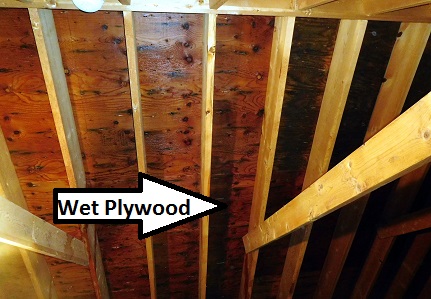Frost itself doesn t do any damage but once it melts things get wet and then damage occurs.
Attic sheathing wet.
Prolonged wetness will rot out the roof sheathing.
If you have ceiling leaks only in the spring it may be that ice has been forming on the sheathing all winter and it suddenly melts when a warm spell arrives.
Mold on attic sheathing.
Mold growing on the sheathing in your attic is a serious problem that shouldn t be ignored.
Trapped water will boil when the sun heats the roof and the shingles will then have small pits where.
It is never a good idea to install a roof over wet plywood or any type of roof sheathing.
There are many signs that an attic is wet.
Water leaks are more obvious as telltale signs such as darkened water stains evidence of mold on the ceiling inside the house or wet sheathing.
The bathroom fan has been replaced and is now vented properly but.
Melting frost can lead to deteriorated roof sheathing mold on the roof sheathing wet insulation and water stains on the ceilings.
Buckled or damaged roof sheathing.
In the vast majority of cases the mold growth is caused by condensation.
Moist or wet insulation.
The osb and in fact any wood panels must be allowed to dry completely depending on how wet the panels are this could be a few days before any roofing material is applied to avoid trapping moisture under the roof material that could cause edge swell and buckling.
There appears to be some kind of mold up there but there is no access to the attic due to a very low pitched roof.
When moisture gets into the attic it condenses on the roof sheathing in the form of frost.
These signs can vary contingent on the catalyst of the problem and are generally worse on north facing or shady sides of roofs.
Installation tips osb roof sheathing the ol sage builder trubord.
Does mold on attic sheathing have to be removed.
How does condensation get in the attic.
What to do about a wet attic.
The presence of mold inside your home even if it.
Water or drip marks scattered on the attic floor.
This occurs when the temperature of the sheathing drops below the dew point creating a thin layer of moisture on the substrate.
Moisture or frost on the roofs sheathing.
And that the sheathing was extremely wet.
Wet sheathing was found in attic area due to lack of venting.
Often this is first noticed when re shingling.

